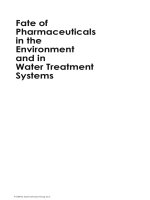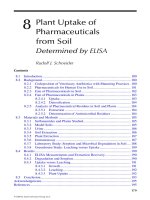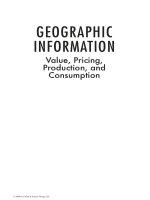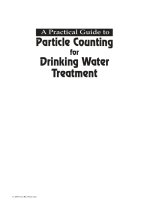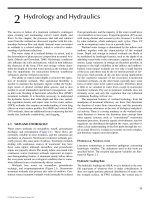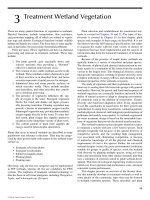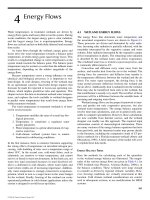TREATMENT WETLANDS - CHAPTER 1 potx
Bạn đang xem bản rút gọn của tài liệu. Xem và tải ngay bản đầy đủ của tài liệu tại đây (1.44 MB, 42 trang )
SECOND EDITION
TREATMENT WETLANDS
© 2009 by Taylor & Francis Group, LLC
CRC Press is an imprint of the
Taylor & Francis Group, an informa business
Boca Raton London New York
ROBERT H. KADLEC
SCOTT D. WALLACE
SECOND EDITION
TREATMENT WETLANDS
© 2009 by Taylor & Francis Group, LLC
Cover Design: Susan Knapp.
CRC Press
Taylor & Francis Group
6000 Broken Sound Parkway NW, Suite 300
Boca Raton, FL 33487-2742
© 2009 by Taylor & Francis Group, LLC
CRC Press is an imprint of Taylor & Francis Group, an Informa business
No claim to original U.S. Government works
Printed in the United States of America on acid-free paper
10 9 8 7 6 5 4 3 2 1
International Standard Book Number-13: 978-1-56670-526-4 (Hardcover)
This book contains information obtained from authentic and highly regarded sources. Reasonable efforts have been made to publish reliable data and
information, but the author and publisher cannot assume responsibility for the validity of all materials or the consequences of their use. The authors and
publishers have attempted to trace the copyright holders of all material reproduced in this publication and apologize to copyright holders if permission
to publish in this form has not been obtained. If any copyright material has not been acknowledged please write and let us know so we may rectify in any
future reprint.
Except as permitted under U.S. Copyright Law, no part of this book may be reprinted, reproduced, transmitted, or utilized in any form by any electronic,
mechanical, or other means, now known or hereafter invented, including photocopying, microfilming, and recording, or in any information storage or
retrieval system, without written permission from the publishers.
For permission to photocopy or use material electronically from this work, please access www.copyright.com ( or contact
the Copyright Clearance Center, Inc. (CCC), 222 Rosewood Drive, Danvers, MA 01923, 978-750-8400. CCC is a not-for-profit organization that provides
licenses and registration for a variety of users. For organizations that have been granted a photocopy license by the CCC, a separate system of payment
has been arranged.
Trademark Notice: Product or corporate names may be trademarks or registered trademarks, and are used only for identification and explanation with-
out intent to infringe.
Library of Congress Cataloging-in-Publication Data
Kadlec, Robert H.
Treatment wetlands / Robert H. Kadlec and Scott Wallace. 2nd ed.
p. cm.
Includes bibliographical references and index.
ISBN 978-1-56670-526-4 (alk. paper)
1. Sewage Purification Biological treatment. 2. Wetlands. I. Wallace, Scott. II. Title.
TD755.K33 2008
628.3’5 dc22 2007042734
Visit the Taylor & Francis Web site at
and the CRC Press Web site at
© 2009 by Taylor & Francis Group, LLC
Contents
Part I
Technical Underpinnings 1
Chapter 1 Introduction to Treatment Wetlands 3
1.1 Wetland Characteristics 3
1.2 Types of Treatment Wetlands 5
FWS Wetlands 5
HSSF Wetlands 6
VF Wetlands 6
1.3 Wetlands as a Treatment Technology 8
Municipal Wastewater Treatment 8
Domestic Wastewater Treatment 10
Animal Wastewater Treatment 10
Minewater Treatment 10
Industrial Wastewater Treatment 10
Leachate and Remediation 10
Urban Stormwater Treatment 11
Field Runoff Treatment 11
1.4 Historical Perspective 11
Development of Treatment Wetlands in North America 13
Treatment Wetlands in Europe 15
Treatment Wetlands in Australia, New Zealand, Africa, Asia, and South America 18
Summary 19
Chapter 2 Hydrology and Hydraulics 21
2.1 Wetland Hydrology 21
Hydrologic Nomenclature 21
Mean Water Depth 22
Wetland Water Volume and Nominal Detention Time 22
Overall Water Mass Balances 26
Inows and Outows 26
Combined Effects: The Wetland Water Budget 33
2.2 FWS Wetland Hydraulics 34
The Calculation Structure 34
Friction Equations for FWS Wetland Flows 36
Wetland Data 39
2.3 HSSF Wetland Hydraulics 42
Flow in Porous Media 42
Adaptations for HSSF Wetlands 42
Correlations for Hydraulic Conductivity of Clean Bed Porous Media 44
Clogging of HSSF Bed Media 44
HSSF Water Elevation Proles 49
Flooded Operation 50
Flow Stratication 51
2.4 VF Wetland Hydraulics 52
Intermittent Downow Beds 53
Vertical Flow Tracer Tests 55
Clogging 56
Summary 57
© 2009 by Taylor & Francis Group, LLC
Chapter 3 Treatment Wetland Vegetation 59
3.1 Ecology of Wetland Flora 60
Wetland Bacteria and Fungi 60
Wetland Algae 61
Wetland Macrophytes 64
Oxygen Transport as a Treatment Function 69
3.2 Biomass and Growth 70
Fertilizer Response 71
Seasonal Patterns 72
Individual Plants 74
Plant Coverage 74
3.3 Litterfall and Decomposition 76
Litterfall 76
Decomposition 77
Patterns of Weight Loss 77
Combined Effects of Successive Cohorts 79
Belowground Decomposition 79
Thatch 79
Mineral Constituents of Litter 80
Accretion 81
Background Concentrations 82
Wastewater Stresses 83
3.4 Vegetative Communities in Treatment Wetlands 84
Algal Systems 84
Submerged Plants 85
Floating Plants 85
Unintended Floating Mats in Treatment Wetlands 88
Floating Mat Constructed Wetlands 89
Woody Plants 90
Woody Plants in Stormwater Wetlands 92
Wastewater and Natural Forested Wetlands 92
Emergent Soft Plants 96
Examples of Modern Emergent Community Choices 97
3.5 Weeds 99
Examples of Weeds in Treatment Wetlands 99
Summary 100
Chapter 4 Energy Flows 101
4.1 Wetland Energy Flows 101
Energy Balance Terms 101
Heating or Cooling of the Water 105
Changes in Storage: Thermal Inertia 106
Heat of Vaporization 106
4.2 Evapotranspiration 107
Methods of Estimation for E, T, and ET 107
Surface Flow Wetlands 109
Subsurface Flow Wetlands 109
Size Effects on ET 110
Transpiration: Flows into the Root Zone 112
4.3 Wetland Water Temperatures 113
Short-Term Cycles 115
Annual Cycles 115
Predicting Wetland Water Balance Temperatures 118
Water Temperature Variability 119
The Accommodation Zone 121
© 2009 by Taylor & Francis Group, LLC
4.4 Cold Climates 125
Spatial Extent and Distribution of Ice in FWS Wetlands 126
Insulation of HSSF Wetlands 129
Warm Water Inuents to HSSF Wetlands 131
Summary 131
Chapter 5 Air, Water, and Soil Chemical Interactions 133
5.1 Fundamentals of Transfer 133
5.2 Oxygen Dynamics in Treatment Wetlands 134
Biochemical Production of Oxygen 135
Physical Oxygen Transfers 135
Plant Oxygen Transfer 137
Biological and Chemical Oxygen Consumption 138
Wetland Proles 139
Trends and Variability 143
5.3 Volatilization 144
Nitrous Oxide 144
Methane 146
Carbon Dioxide 147
Greenhouse Effects 148
5.4 Oxidation-Reduction Potential 149
Redox Potentials in Treatment Wetlands 151
5.5 Wetland Hydrogen Ion Concentrations 151
Surface Flow Wetlands 151
Subsurface Flow Wetlands 153
Wetlands Treating Acid Mine Drainage 157
Substrate Effects 158
5.6 Alkalinity and Acidity 159
Alkalinity in Treatment Wetlands 159
Carbonates in Treatment Wetlands 159
Summary 161
Chapter 6 Representing Treatment Performance 163
6.1 Variability in Treatment Wetlands 163
Intrasystem Variability 163
Data Folding 163
Intersystem Variability 164
Replication 165
Side-by-Side Studies 165
Aggregated Data Sets 165
6.2 Graphical Representations of Treatment Performance 166
Outputs Versus Inputs 166
Perspectives Derived from the Loading Graph 167
Pitfalls of Graphical Representations 168
6.3 Mass Balances 169
Concentrations 169
Chemical Terminology 170
Chemical Mass Balances 170
6.4 Processes that Contribute to Pollutant Removals 172
Microbially Mediated Processes 172
Chemical Networks 174
Volatilization 174
Sedimentation 174
Sorption 174
Photodegradation 174
Plant Uptake 175
© 2009 by Taylor & Francis Group, LLC
Vertical Diffusion in Soils and Sediments 175
Transpiration Flux 175
Seasonal Cycles 176
Accretion 176
6.5 Characterization of Internal Hydraulics 176
Tracer Tests 176
Interpretation of Data 177
Models for Internal Hydraulics 179
6.6 Reaction Rate Models 186
Intrinsic Chemistry 186
Batch versus Flow Systems 188
The TIS Model 188
Mixtures, Weathering, and the P-k-C* Model 190
Synoptic Error 193
6.7 Other Factors Affecting Treatment Performance 194
Denition of the Rate Constant 194
Temperature and Season 196
Variability and Data Folding 196
Water Losses and Gains 197
Interactions with Solids 198
System Start-Up 199
6.8 Dangers of Extrapolating Wetland Performance Data 200
Summary 201
Chapter 7 Suspended Solids 203
7.1 Solids Measurement 203
Potential for Sampling Errors 203
Solids Characterization 205
7.2 Particulate Processes in FWS Wetlands 206
Particulate Settling 206
“Filtration” versus Interception 209
Resuspension 210
Chemical Precipitates 211
Biological Sediment Generation 213
Accretion 213
7.3 TSS Removal in FWS Wetlands 216
Internal Cycling: Mass Balances 216
The w-C* Model 216
Internal Cycling 217
Seasonal and Stochastic Effects 218
Input–Output Relations 220
Open Water Areas 223
Pond–Wetland Combinations 223
Submerged Aquatic Vegetation (SAV) 226
7.4 Particulate Processes in HSSF Wetlands 226
Particulate Settling 226
Filtration and Interception 227
Resuspension 227
Chemical Precipitation 227
Production of Biological Solids 227
Accretion and Bed Clogging 228
7.5 TSS Removal in HSSF Wetlands 228
Seasonal and Stochastic Effects 229
Input–Output Relations 230
© 2009 by Taylor & Francis Group, LLC
7.6 TSS Removal in VF Wetlands 232
Intermittent Downow Beds 232
Input–Output Relations 234
Summary 235
Chapter 8 Carbon and Biochemical Oxygen Demand 237
8.1 Wetland Carbon Speciation and Processing 237
BOD, COD, and TOC 237
Wetland Chemistry of Carbon 238
Organic Carbon 239
Carbon Processing in Wetland Necromass and Soils 240
8.2 BOD Removal in FWS Wetlands 241
Annual Input–Output Concentration Relations 242
First-Order Modeling 242
Model Curves 244
Variability in Annual Performances 246
Effects of Design and Operating Conditions 247
Seasonal Trends 249
8.3 BOD Removal in HSSF Wetlands 253
First-Order Modeling 255
Graphical Relations 257
Temperature Effects 258
Oxygen Supply 258
Seasonal Trends 260
Effects of Design and Operating Conditions 260
8.4 BOD Removal in VF Wetlands 264
Graphical Relationships 264
First-Order Modeling 265
Seasonal Effects 266
Summary 266
Chapter 9 Nitrogen 267
9.1 Nitrogen Forms in Wetland Waters 267
Organic Nitrogen 267
Ammonia 268
Oxidized Nitrogen 268
9.2 Wetland Nitrogen Storages 268
Soils and Sediments 268
Biomass 270
9.3 Nitrogen Transformations in Wetlands 272
Physical Processes 273
Theoretical Considerations 276
Microbial Processes 277
Nitrication of Ammonia 279
Denitrication 280
Aerobic Denitrication 284
Anaerobic Ammonia Oxidation (Anammox) 284
Nitrogen Fixation 284
9.4 Vegetation Effects on Nitrogen Processing 285
The Effects of Vegetation Growth and Cycling 286
Accretion of Nitrogenous Residuals 288
Short-Term Anomalies 288
Harvest to Remove Nitrogen 289
Soil and Sediment Effects on Nitrogen Processing 290
© 2009 by Taylor & Francis Group, LLC
9.5 Nitrogen Mass Balances 290
Mass Balance Case Studies 290
Implications of the Nitrogen Mass Balance Network 296
9.6 Performance for Organic Nitrogen 296
Loading Considerations 296
Background Concentrations of Organic Nitrogen 298
Rates and Rate Constants 299
9.7 Performance for TKN 301
Loading Considerations 301
Background Concentrations of TKN 302
Rates and Rate Constants 303
9.8 Performance for Total Nitrogen 308
Loading Considerations 308
Background Concentrations of Total Nitrogen 310
Rates and Rate Constants 310
Intrasystem Variability 314
9.9 Performance for Ammonia 316
Reduction of Ammonia in FWS Wetlands 316
Reduction of Ammonia in HSSF Wetlands 318
Reduction of Ammonia in VF Wetlands 322
Background Concentrations of Ammonia 323
Rates and Rate Constants 323
Intrasystem Variability 331
9.10 Performance for Oxidized Nitrogen 335
Loading Considerations 335
Background Concentrations of Nitrate 338
Rates and Rate Constants 338
Intrasystem Variability 342
9.11 Multi-Species Nitrogen Modeling 343
Sequential Nitrogen Models: An Illustration 343
Sequential Nitrogen Models in the Literature 344
Summary 347
Chapter 10 Phosphorus 349
10.1 Phosphorus Forms in Wetland Waters 349
10.2 Wetland Phosphorus Storages 351
Plant Biomass 351
Soils and Sediments 354
10.3 Phosphorus Processing in FWS Wetlands 357
Sorption 357
Biomass Storage and Cycling 359
Herbivory and Phosphorus Movement 363
Sustainable Removal: Accretion 364
Sustainable Removal: Particulate Settling 365
Vertical Phosphorus Movement 365
Soil Phosphorus Release 367
Atmospheric Phosphorus Processes 369
10.4 Spatial and Temporal Phosphorus Effects in FWS Wetlands 371
Wetland Start-Up 371
Phosphorus Gradients in FWS Treatment Wetlands 372
10.5 Phosphorus Removal in FWS Wetlands 374
Background Concentrations of Total Phosphorus 374
Loading Considerations 375
10.6 FWS Wetland Detailed Phosphorus Modeling 382
Aquatic Systems in General 382
Phosphorus Models for Everglades Wetlands 383
© 2009 by Taylor & Francis Group, LLC
10.7 Intrasystem Phosphorus Variability in FWS Wetlands 383
Stochastic Behavior 383
Anticipated Excursion Frequencies 384
10.8 Longevity of Phosphorus Removal in FWS Wetlands 386
Long-Term Track Records 386
Historical Unplanned Projects 387
Reasons for Low or Negative Reduction 388
10.9 Phosphorus Processing in Subsurface Flow Wetlands 388
Sorption 388
Biomass Cycling 394
Chemical Precipitation 395
Accretion 395
Particulate Settling 395
10.10 Phosphorus Movement in Subsurface Flow Wetlands 395
Effect of Bed Sorption on Phosphorus Movement 396
Idealized Model of Sorption 396
10.11 Phosphorus Removal in Subsurface Flow Wetlands 399
Background Concentrations of Total Phosphorus 399
Seasonal Effects 399
Input–Output Relationships 399
Stochastic Variability 401
Summary 401
Chapter 11 Halogens, Sulfur, Metals, and Metalloids 403
11.1 Halogens 403
Chloride and Chlorine 403
Bromide and Bromine 406
Fluoride and Fluorine 407
11.2 Alkali Metals 408
Sodium 408
Potassium 408
Calcium 408
Magnesium 410
11.3 Collective Parameters 410
Hardness 410
Total Ion Content 410
11.4 Sulfur 413
Dissimilatory Sulfate Reduction 413
Hydrogen Sulde 414
Oxidation of Sulfur and Suldes 416
Organic Sulfur 416
Phytotoxicity 416
Performance of Wetlands for Sulfur Removal 417
Sulfur-Induced Eutrophication 417
11.5 Trace Metals: General Considerations 419
Toxic Effects in Water and Sediments 419
Abiotic Metal Partitioning 419
Sorption Relations 420
Equilibrium Metal Chemistry Calculations 421
Design Equations for Metal Removal 421
Storage in Plants 423
Sediment Storage Concentrations 423
11.6 The Oxide Formers 426
Iron 426
Aluminum 431
Manganese 434
© 2009 by Taylor & Francis Group, LLC
11.7 Heavy Metals 438
Copper 438
Nickel 444
Lead 447
Cadmium 453
Chromium 457
Zinc 462
Mercury 466
11.8 Metalloids 470
Arsenic 470
Boron 473
Selenium 475
Summary 480
Chapter 12 Pathogens 483
12.1 Indicator Organisms and Measurement 483
12.2 Pathogen Removal Processes 485
Solar Disinfection 485
Predation 486
Settling and Filtration 486
Mortality and Regrowth 487
Reintroduction 488
12.3 Fecal Coliform Removal in FWS Wetlands 489
First-Order Removal Models 489
Input–Output Relation for Fecal Coliforms 494
12.4 Removal of Other Indicator Bacteria in FWS Wetlands 496
Total Coliforms 496
Fecal Streptococcus 497
Escherichia coli 497
Miscellaneous Bacteria 497
12.5 Parasite and Virus Removal in FWS Wetlands 497
Parasites 497
Viruses 497
Wildlife Pathogens 499
12.6 Fecal Coliform Removal in SSF Wetlands 500
Effect of Vegetation 501
Effect of Depth 503
Effect of Media Size and Uniformity 503
Background Concentrations 503
First-Order Removal Models 505
Rate Constants 506
Seasonal Trends 506
Temperature Coefcients 507
Variability 508
12.7 Removal of Other Bacteria in SSF Wetlands 508
Total Coliforms 508
Miscellaneous Bacteria 509
12.8 Parasite and Virus Removal in SSF Wetlands 511
Parasites 511
Viruses 515
Summary 515
© 2009 by Taylor & Francis Group, LLC
Chapter 13 Organic Chemicals 517
13.1 Petroleum Hydrocarbons 517
BTEX 517
Alkanes 520
Polycyclic Aromatic Hydrocarbons 520
13.2 Chlorinated Hydrocarbons 522
Chlorinated Benzenes 522
Chlorinated Ethenes 523
13.3 Organic Chemicals 524
Explosives 524
De-icing Compounds 527
Phenols 528
Surfactants 530
Miscellaneous Hydrocarbons 531
13.4 Pesticides 531
Atrazine 532
13.5 Cyanide 535
Summary 537
Chapter 14 Event-Driven Wetlands 539
14.1 Source Characterization 539
Incoming Flows 539
Incoming Concentrations and Loads 541
Hydrology of Pulsed and Seasonal Systems 543
Flow and Capture 545
14.2 Technology Status 547
Urban Stormwater 547
Agricultural Stormwater 549
Industrial Stormwater 550
Batch Systems 551
Combined Sewer Overow (CSO) 553
14.3 TSS in Event-Driven Wetlands 553
Dynamic Responses 554
Intersystem Performance 554
14.4 Phosphorus in Event-Driven Wetlands 555
Flow Pulses 555
Event Sequences 558
Urban Stormwater 559
Agricultural Runoff 560
14.5 Nitrogen in Event-Driven Wetlands 560
Nitrate Pulses 560
Ammonia Pulses 562
Nitrogen Reduction in Urban Stormwater 564
Agricultural Runoff 564
14.6 Metals in Event-Driven Wetlands 565
14.7 Pesticides in Event-Driven Wetlands 568
14.8 Dynamic Modeling 568
The Dynamic Model for Stormwater Treatment Areas (DMSTA) 568
Variability 570
Summary 570
© 2009 by Taylor & Francis Group, LLC
Part II
Implementation 571
Chapter 15 Evolution of Sizing Methods 573
15.1 Historical Perspectives 573
First-Order Modeling 574
Loading Specications 575
Regression Equations 576
15.2 Free Water Surface Wetlands 577
15.3 Stormwater Wetlands 577
15.4 Horizontal Subsurface Flow Wetlands 578
The Root-Zone Method 578
Evolution of HSSF Wetland Design in Europe 578
Evolution of HSSF Wetland Design in North America 580
Reections on Old HSSF Design Procedures 582
15.5 Vertical Flow Wetlands 582
Design of Vertical Flow Wetlands in Europe 582
Loading Specications 584
Implied Oxygen Transfer 584
Computer Models 585
15.6 Common Design Misunderstandings 585
Area- and Volume-Based Rates 585
Temperature Coefcients 586
Excursion Containment and Safety Factors 586
15.7 A Critique of Design Methods 586
Loading Specication 586
Loading-Based FWS Sizing—An Example 587
Loading-Based FWS Sizing—Difculties 587
Exponential Decline Models 588
15.8 A Performance-Based Sizing Algorithm 589
15.9 Guidelines and Manuals 589
Obsolete Manuals 589
Current Manuals 590
Summary 591
Chapter 16 Design Basis 593
16.1 Project Setting 593
Space Considerations: Limited versus Unlimited Space 593
Soils and Geology 594
Groundwater 594
Altitude 595
Biological Conditions 596
16.2 Characterization of Domestic and Municipal Wastewater 596
Water Quantity 597
Small Domestic Systems 597
Small Flows 597
Patterns of Small Flows 597
Actual Water Use 598
Inltration and Inow 598
Water Quality 599
16.3 Characterization of Other Wastewaters 602
Industrial Wastewaters 602
Landll Leachates 602
Pulp and Paper Wastewater 603
Mine Drainage 603
© 2009 by Taylor & Francis Group, LLC
Petroleum Industry Wastewater 603
Animal Industry Wastewaters 604
Stormwater Runoff 604
16.4 Treatment Goals 606
Receiving Water Standards 606
Groundwater Discharges 606
Interfacing to Reuse 607
Excursion Containment and Safety Factors 607
Other Design Parameters 609
Toxicity Reduction in FWS Wetlands 609
16.5 Climate and the Water Budget 610
Climate 610
Rainfall 611
Evapotranspiration 611
Seepage 611
Temperature 612
16.6 Selection of Wetland Type 614
“Natural” versus “Engineered” Systems 614
FWS or HSSF? 615
Other Natural Systems 619
16.7 Pre- and Post-Treatment Requirements 621
Pretreatment 621
Wetland Survival Limits 621
Excessive Solids 621
Phosphorus Precipitates 621
Excessive Nitrogen 622
Strong Specialty Chemicals 622
Excessive Sulde 623
Oxygenation of Wetland Inuents 623
Postwetland Requirements 624
Summary 624
Chapter 17 Sizing of FWS Wetlands 627
17.1 Pollutant Reductions and Performance Computations 627
Water Budget 627
Pollutant Mass Balances 628
Interconnected Pollutants: The Case of Nitrogen 630
Design Parameters: Sources of Information 630
Design Sizing Goals: Load Reduction versus Concentration Reduction 632
17.2 Area Computations 633
Goal Seeking: Determination of the Required Wetland Area 633
Minimum Load Reduction Criterion 634
Multiple Compounds of Concern 634
17.3 Checking the Biogeochemical Cycles 634
C, N, and P Cycles 635
17.4 Chemical Supply Constraints 638
Oxygen Supply 639
Carbon Supply 639
Intersystem Performance Checks 639
17.5 Adjustments for Seasonality 641
Wetland Water Temperature 642
Temperature Coefcients 643
Rate-Constant Adjustment 643
Monthly Rate Coefcients 643
Trend Amplitudes 644
Winter Storage versus Winter Operation 645
© 2009 by Taylor & Francis Group, LLC
17.6 Stormwater Wetlands 647
Inow Estimation 648
Hydraulic Considerations 649
Percentage of the Contributing Watershed 649
Design Storm Detention 650
Annual Average Performance 650
Detailed Dynamic Simulations 651
Flow Equalization versus Pulse Operation 651
Summary 653
Chapter 18 Implementation of FWS Wetlands 655
18.1 Physical Design 655
Siting 655
Other Regulatory Concerns 655
Cultural Resources 656
Layout and Conguration 657
Fitting the Wetlands to the Site 665
18.2 Hydraulics 666
Hydraulic Proles 667
18.3 Earthmoving: Dikes, Berms, and Levees 668
Berm Design 668
Basin Bottom Contouring: Cut and Fill 669
Liners and Rooting Media 670
Erosion and Flood Protection 671
18.4 Water Control Structures 672
Controlling Inow 672
Spreading the Water 672
Outlets 675
Water Collection 675
Level Control 675
Trash Racks 677
Emergency Overows 677
Pumps 677
18.5 Stormwater Wetlands 678
Bathymetry 678
Control Structures 678
Supplemental Water Source 679
18.6 Wetland Construction 679
Site Preparation 679
Grading and Subgrade Preparation 680
Liner Placement 681
Rooting Soil Placement 681
Piping and Structures 682
18.7 Vegetation Establishment 682
Selection of Plants 682
Treatment Potential 683
Diversity 683
Plant Propagules and Sources 685
Planting Density 687
Planting 687
Plant Establishment 687
Summary 689
Chapter 19 Ancillary Benets 691
19.1 Vegetative Biodiversity 691
Wetland Plants 691
© 2009 by Taylor & Francis Group, LLC
Water Regime 692
Propagation 693
Biodiversity 693
19.2 Wildlife 694
Macroinvertebrates 695
Fish 696
Amphibians and Reptiles 697
Birds 697
Mammals 699
19.3 Design and Wildlife Use 702
Design to Encourage Wildlife 702
Design to Discourage Incompatible Wildlife 703
Ecological Risk Analysis 703
19.4 Human Use 704
Consumptive Activities 704
Passive Activities 705
Conicts 705
19.5 Design for Ancillary Benets 706
Siting 706
Cell Size and Conguration 707
Vegetation 707
Pretreatment 708
Human Access 708
Examples 708
Summary 713
Chapter 20 Sizing of SSF Wetlands 715
20.1 Prescriptive Sizing Criteria 715
Loading Charts 715
Scaling Factors 717
Empirical Equations 718
20.2 Performance-Based Wetland Sizing 718
Basic Application of the P-k-C* Model to HSSF Wetlands 718
Water Budget Effects 719
Pollutant Mass Balances 720
Interconnected Pollutants 721
20.3 Accomplishing Performance-Based Sizing for HSSF Wetlands 722
Conservatism in Design 723
Most Basic Case: Consideration of Concentration Reduction Only, No Change in Flow 724
Second Case: Pollutant Reductions under Variable Flow 724
Role of C* in Pollutant Reduction 724
Seasonal and Stochastic Variability 726
Cross-Checks against Existing Performance Data 727
Biogeochemical Cycle Constraints 728
20.4 VF Wetlands (Intermittently Loaded Beds) 729
Development 729
Sizing 730
Number of Beds 733
20.5 VF Wetland Sizing (Recirculating Filters) 733
20.6 Biosolids Wetlands for Sludge Dewatering 734
20.7 Secondary Considerations 734
Seasonal Impacts of the Biomass Cycle 734
Thermal Energy Balance Limitations 734
Summary 734
© 2009 by Taylor & Francis Group, LLC
Chapter 21 Implementation of SSF Wetlands 735
21.1 Siting 735
Construction Access 735
Slopes 736
Existing Utilities 736
Floodplains 737
Regulatory Issues 737
21.2 Layout and Conguration 738
Number of Flow Paths 738
Operational Flexibility 738
Treatment Redundancy 739
Loading and Resting 739
21.3 Number and Type of Wetlands in Each Flow Path 739
Greater Treatment Efciency 739
Dividing Wetland Cells Based on Slope 740
More Than One Wetland Type 740
Staged Treatment 741
21.4 Clogging Dynamics 741
Dening Failure in SSF Wetlands 741
Clogging in HSSF Wetland Beds 742
Clogging in VF Wetland Beds 744
21.5 Cell Conguration 744
Length-to-Width Ratio 745
Wetland Cell Depth 746
Type and Size of Bed Media 747
SSF Wetland Cell Size 748
21.6 SSF Wetland Hydraulics 748
Hydraulics of VF and Biosolids Wetlands 753
21.7 Flow Distribution and Management 753
HSSF Wetlands 753
VF Wetlands 753
Biosolids Wetlands 756
Efuent Flow Collection 756
Water Level Control 756
21.8 Liner Systems 757
Thermal Considerations 757
21.9 SSF Wetland Construction 757
Elevations and Grading 758
Liners 758
Berms 759
Vertical Sidewalls 760
Inuent and Efuent Piping 762
Bed Media Placement 762
Installation of Control Structures 763
21.10 Commissioning and Start-Up 764
Plant Selection 764
Vegetation Establishment 764
Summary 766
Chapter 22 Management, Operations, and Maintenance 767
22.1 Start-Up 767
Antecedent Conditions 767
Vegetation Start-Up 769
© 2009 by Taylor & Francis Group, LLC
22.2 Monitoring 770
Sampling and Analyses in Support of Mass Balances 771
Biological Monitoring 774
Monitoring Vegetation 774
22.3 Water Level and Flow Management 774
Flow Management 774
Depth Controllability 776
Water Depth, Plants, and Nutrient Loadings 777
Seasonal Depth Adjustments 778
22.4 Control of Nuisance Animals 778
Birds 778
Fish 779
Rodents 780
Insects 784
22.5 Vegetation Management 786
General System Care 786
Harvesting 786
Weeds 786
Burning 787
22.6 Maintenance of Structures 788
22.7 Long-Term Prospects 788
FWS Wetlands 788
SSF Wetlands 789
22.8 Assistance to the Operator 791
Summary 792
Chapter 23 Economics 793
23.1 Capital Costs 793
Regional Variation 793
Direct Costs 794
Indirect Costs 805
Illustrations 806
Economy of Scale 807
23.2 Operation and Maintenance Costs 809
Free Water Surface Wetlands 810
Subsurface Flow Wetlands 810
23.3 Present Worth Analyses 811
Present Worth Concepts 812
Annualized Cost 814
Economics of Storage 814
Summary 817
Chapter 24 Modied and Combined Systems 819
24.1 Ecological or Environmental Modications 819
Microbial Enhancement 820
Willow Wetlands with Zero Discharge 820
Engineered Plants 821
Articial Enclosures 821
24.2 Chemical Additions 822
Reactants via Media 822
Reactants via Added Streams 822
24.3 Operational Strategies 826
Step Feed 826
Recycle 828
© 2009 by Taylor & Francis Group, LLC
FWS Timed Operational Sequences 829
SSF Timed Operational Sequences 830
24.4 Integrated Natural Systems 831
Ponds and Wetlands 832
FWS and Inltration 834
Overland Flow to FWS 838
Vertical Flow to FWS 838
SSF and Inltration 839
VF and HSSF Combinations 840
Summary 840
Chapter 25 Wetlands by Application Group 841
25.1 Animal Wastes 841
Conned Animal Operations 841
Poultry 842
Cattle 843
Dairy Operations 843
Swine 848
Zoos 849
Aquaculture 849
25.2 Food-Processing Wastewaters 852
Sugar Rening 852
Potato Processing 852
Milk Products 853
Meat Processing 854
Beer, Wine, and Spirits 855
Vegetables 856
25.3 Landll Leachate 857
Treatment Wetlands for Landll Leachate 858
Design Considerations 859
Water Budget Considerations 859
Wetland Vegetation 860
Ammonia Removal 861
Volatile Hydrocarbons 861
Trace Toxicants 861
Iron 862
Trace Metals 863
Receiving Waters 863
Scale-Up 864
25.4 Industrial Wastewaters 864
Wood Leachates 864
Pulp and Paper Wastewaters 865
Fertilizer Manufacture 866
Summary 867
References 869
Appendix A: Lists of Basis Wetlands 945
Appendix B: Tracer Testing and Flow-Pattern Modeling 965
© 2009 by Taylor & Francis Group, LLC
Since the rst edition of this book, treatment wetland technol-
ogy has advanced on all fronts. Considerably more is known
today about how treatment wetlands function. Over the last
decade, wetland technology has evolved into new reactor
congurations, a much broader range of treatment applica-
tions, and a dramatically expanded presence worldwide.
This growing knowledge base leads to an increased
appreciation of just how complex treatment wetlands are.
Because treatment wetlands are strongly inuenced by a vari-
ety of internal and external ecological cycles, the assump-
tions that simplify the analysis of conventional reactors in the
environmental engineering eld can no longer be justied.
As wetland technology continues to evolve, much effort is
being applied to understand both short-term and long-term
variability cycles within treatment wetlands. Because treat-
ment variability strongly inuences wetland design, factors
that inuence performance—especially the role of internal
biogeochemical cycles—become paramount in understand-
ing how treatment wetlands function. This knowledge can
then be applied to make informed decisions regarding wet-
land design.
WHAT IS A WETLAND?
The meaning of the word wetland has been severely stretched
in the treatment wetland literature. We would generally insist
that wetlands have plants, water, and some kind of media.
Without plants they are soil, sand, or gravel lters, or ponds.
In fact, planted gravel lters— meaning all subsurface ow
wetlands—have no natural wetland analog. Similarly, it is
not unusual to hear discussion of “treatment wetlands” that
do not have plants. We have tried to use commonly accepted
terminology for systems that are generally regarded as
within the scope of the treatment wetland eld. We have
also distinguished systems based on their hydrology, which
may be horizontal ow, pulse-feed vertical, ll-and-drain, or
recirculating.
SCALING FACTORS
Treatment wetlands are in-the-ground, outdoor systems. With
other visions guiding them, treatment wetland researchers some-
times nd wetlands to be potted plants, pots lled with gravel
and no plants, sections of pipe, asks, test tubes, and all man-
ner of tubs, tanks, and troughs, sometimes with recently inserted
propagules. Indoor systems do not experience wind, sun, birds,
and animals. When the size is too small, the system is sub-
ject to severe edge effects. Although comparative results from
small lab systems are useful, there is often the unstated assump-
tion that they would represent the treatment performance of a
full-scale wetland. We have tried to be reasonably careful by
drawing attention to scale with the terms microcosm, mesocosm,
and pilot project.
SHORT-TERM STUDIES
We nd too many studies are based on infant or juvenile eco-
systems, which have not had time to mature into the full suite
of components that occur in fully developed wetlands. We
also nd too many studies focus on short-term events. This,
we believe, is like interpreting the meal-time hamburger
intake rate of teenage boys and girls as their sustainable
caloric intake.
For instance, the development of bed clogging in HSSF
wetlands has not been studied in a systematic way in the aca-
demic community. Recent knowledge of bed clogging has
come from the hydraulic failure of full-scale systems (often
at a high price) because clogging phenomena takes longer
to develop than the tenure of a typical graduate student. As
a result, the long-term viability, and maintenance require-
ments, of HSSF wetlands is still unknown, despite the fact
that thousands of systems have been constructed worldwide.
It is fortunate that there are now numerous full-scale
projects to balance the data scales.
WHAT’S NEW?
Of course, there is much more information available now
than in 1995 when the previous analyses were completed.
The doubling time of the available data is on the order of two
or three years, because old systems continue to return new
information as more and more systems come on line in more
and more application areas. As a consequence, about 90% of
the data used in support of this book was not available at the
time of the rst edition. It has been reassuring to nd that
most of the data and interpretations of the rst edition have
stood up well to the test of time, but not surprising to nd that
some numerical interpretation had to be updated.
Data analysis in the rst edition was predicated on the
plug ow assumption, despite the known fact that virtually no
treatment wetland actually tested out as plug ow. It is now
understood that while this may provide acceptable interpola-
tion on existing performance ranges, it can lead to very bad
extrapolations that should not be used in design. Further, it has
been recognized that weathering of the mixtures that com-
prise many of the standard wastewater parameters will also
invalidate the plug ow assumption. Accordingly, a mixing
parameter has been added to the mathematical representation
of wetland behavior.
Preface
© 2009 by Taylor & Francis Group, LLC
DESIGN TOOLS
With the advent and proliferation of desktop computing,
expectations for calculational detail have risen markedly
in the last 15 years. It is no longer necessary to be given a
single equation, arranged to be solved for the single variable
of interest. This second edition is predicated on the exten-
sive use of spreadsheets, and the large array of iterative and
optimization tools that go with them. The scientic design
team for a constructed wetland must include that capability,
or else be constrained to simple scale-up or scale-down for a
repetitive design.
In the rst edition, central tendency rate coefcients
were presented, along with tables detailing the values for
individual systems. Several investigators soon found that
their results did not match the central tendencies, and incor-
rectly concluded that something must be wrong. In this edi-
tion, we have therefore opted to present the distributions of
rate coefcients across numerous wetlands of all types, so
that new results may be placed in that spectrum, and designs
may be selected with different positions across the intersys-
tem landscape.
The scatter of wetland outlet concentrations around
an often-seasonal trend is another type of variability to be
accounted. The rst edition utilized maximum monthly devi-
ations across the year. Here, the annual pattern is accounted
separately, based on system performances, and various per-
centiles of the exceedance distribution are presented as a
necessary part of design.
Among the differences between the new and the old data
interpretations, the narrowing of the gaps between surface
and subsurface ow system performance and cost are perhaps
the most intriguing. Based on new and greatly expanded data
analysis, subsurface ow wetlands do not enjoy much of a
performance margin on a per unit area basis, and may be less
effective than surface ow systems for some contaminants.
However, the cost differential is much less than previously
thought, when comparable-sized wetlands are evaluated, but
still remains about a three to one capital advantage for sur-
face ow. Therefore, nuisance and health hazard avoidance
rules the selection of wetland type.
TECHNOLOGY SELECTION
In the early years of constructed wetland technology, and to
some extent continuing today, there was a tendency to con-
sider wetlands as stand-alone devices, usually accompanied
by pretreatment. It is now understood that series and paral-
lel natural system networks, perhaps involving recirculation,
are sometimes better choices. Combinations of vertical ow,
horizontal subsurface ow, ponds, and free water surface
wetlands are increasingly being used.
THIS BOOK
This book has been updated to reect the dramatic advances
in wetland technology over the last 12 years. The authors of
this second edition come from different backgrounds, and
work in different aspects of the treatment wetland eld. By
combining our knowledge and experience, we have endeav-
ored to present a broad range of information regarding
the science, hydrology, hydraulics, reactor theory, applied
design, implementation, cost, and O&M of treatment wetland
systems.
The format of the second edition reects a dual approach.
Part I is organized in a manner that allows the reader to
explore the internal mechanisms by which treatment wet-
lands operate. Existing projects and operating results from
real-world treatment wetlands are utilized extensively. Inter-
nal mechanisms, their inuence on treatment performance,
and their effect on system variability are explored in detail
in Part I.
Part II is organized to allow the reader to examine how
performance data is analyzed and applied to the design pro-
cess. Like the rst edition, this book adopts a performance-
based approach to design, in addition to presenting design
tools such as loading charts and scaling factors. Continuing
with the theme of practical implementation, Part II also sum-
marizes current knowledge that is key to getting wetland
projects built, including construction methods, cost informa-
tion, and operation & maintenance (O&M) requirements.
We have not repeated the natural wetland fundamentals
that are contained in the rst edition, nor have we reiterated
databases or case histories contained therein. All other topics
have been nearly totally rewritten, as required by the vastly
increased data sources and understanding that have devel-
oped in the many years since the rst edition.
However, as much as things have changed, some things
remain the same. The predictions made in the rst edition
about rapid evolution of treatment wetlands have certainly
proven true. We expect that, if anything, this rate of change
will continue to increase after the publication of this second
edition, which might have been more properly called Treat-
ment Wetlands II.
Robert H. Kadlec
Scott D. Wallace
© 2009 by Taylor & Francis Group, LLC
The authors want to acknowledge our families and friends
who supported us while writing this book. For Bob Kadlec,
the extreme patience of his wife Kelli was a paramount virtue,
as she put up with over a year’s worth of working weekends
and the virtual loss of a spouse. Scott Wallace would like to
thank his coworkers at North American Wetland Engineer-
ing, who stepped forward and handled all the challenges of
managing projects and running an engineering company so
he could have the freedom to write this book. It is a pleasure
to work with such a group of excellent people.
A tremendous amount of effort was given by Jan
Vymazal, who helped immensely in the preparation of Part I
of this book. His broad understanding of treatment wetlands
is evidenced in his many authored and edited volumes, and
we are very grateful for his assistance.
Jaime Nivala was instrumental in the completion of this
book. She carefully reviewed every chapter, gure, and table;
her abilities as both coordinating editor and environmental
engineer were invaluable to us. Jaime did an excellent job
of managing the myriad details of producing a book of this
scope, and her organizational skills made the writing process
much easier. This book could not exist in its current form
without her extraordinary efforts.
We also want to thank Sue Knapp, who injected a breath
of life into the cover design and all of the engineering drawings
and hand sketches that are now the nal artwork in this book.
This book expands upon many concepts advanced in the
rst edition, for which Robert Knight bears a full share of
credit. He was a major architect of the foundation for this
work.
The authors wish to acknowledge the efforts of the hun-
dreds of engineers and scientists who have had the courage
to create, innovate, and ultimately develop treatment wet-
lands as a viable technology to solve many environmental
problems. The friendly and open communication between
colleagues at international conferences has made this eld
a pleasure to work in, and the “lessons learned” have greatly
contributed to the rapid evolution of treatment wetlands.
We are very appreciative of those projects that have shared
data with us. Without the data assembled from these diverse
resources, this book could not exist. The list is long, and these
hundreds of project owners are owed heartfelt thanks for their
generosity.
Robert H. Kadlec
Scott D. Wallace
Acknowledgments
© 2009 by Taylor & Francis Group, LLC
Robert H. Kadlec holds B.S., M.S., and Ph.D. degrees in
chemical engineering from the University of Wisconsin and
University of Michigan, 1958–1962. That era saw the culmi-
nation of the “unit operations” approach to chemical process-
ing, and the transition to the use of principles of transport
phenomena to describe transfer and reaction rates in a wide
variety of chemical and biochemical processes. Those tech-
niques and analytical tools are also the foundation of today’s
environmental engineering. Bob began applying engineering
analysis to wetland processes in 1970, with the goal of man-
aging wetlands for water quality improvement. The result
was the Houghton Lake natural wetland treatment system,
which is still operating successfully.
Research on that natural wetland, and on the ensuing 30
years of its operation for engineered treatment, formed the
early framework for Dr. Kadlec’s development of wetland
process characterization. The technology has grown tremen-
dously, and so has Bob’s involvement in treatment wetland
projects. He has participated in over 250 projects, ranging
from simple feasibility studies to comprehensive university
research projects. Early university studies focused primarily
on wetland hydrology and water chemistry. In the course of
many projects, a good deal of knowledge of practical ecology
was imparted by his colleagues.
He has worked on treatment wetlands in many states and
several other countries, participating in the design of over a
hundred treatment wetlands. Major and long-running projects
have included Houghton Lake, Michigan; Incline Village,
Nevada; Hillsdale, Michigan; Columbia, Missouri; and the
Everglades Stormwater Treatment Areas. He is past chair-
man of the International Water Association (IWA) Specialist
Group on the Use of Macrophytes in Water Pollution Con-
trol. He has authored or coauthored over 130 publications on
treatment wetlands, in addition to dozens of project reports.
He was a proposer and developer of the U.S. EPA North
American Treatment Wetland Database.
Dr. Kadlec retired from his teaching duties in 1993, and
is currently doing business as Wetland Management Services,
providing specialty consulting services to a wide range of
governmental and private organizations. His contributions to
this book are an effort to consolidate over three decades of
research and practical experience.
Scott D. Wallace began his career as a wastewater treatment
plant operator, and also worked as a eld technician and ana-
lytical chemist. He earned a B.S. in civil engineering (1986)
and an M.S. in environmental engineering (1989), both
from the University of Iowa. Scott has worked full-time as
a consulting engineer since 1988, and has been employed at
CH2M HILL, Shive-Hattery Engineers and Architects, and
HDR Engineering. Scott began designing treatment wetlands
in 1992, beginning with the Indian Creek Nature Center,
one of the rst cold-climate subsurface ow wetlands in the
United States.
In 1997, he cofounded North American Wetland Engi-
neering (NAWE), a consulting rm focused on the develop-
ment and application of treatment wetlands. Since then, he
has designed over 200 treatment systems, the majority of
which involve wetlands. NAWE was acquired by Jacques
Whitford in 2007, and Scott currently works as a principal
in the Water Resources Sector for Jacques Whitford. He con-
sults on a wide variety of projects in the United States and
internationally.
Scott has been active in research and development, and
holds 5 patents on wastewater treatment systems, including
aerated subsurface ow wetlands, a technology briey dis-
cussed in this book. He is a registered professional engineer
in 22 states, and has written numerous technical papers on
treatment wetlands. Scott was the principal investigator for
Small-Scale Constructed Wetland Treatment Systems; Fea-
sibility, Design Criteria, and O&M Requirements, a design
manual published by the Water Environment Research Foun-
dation (WERF) in 2006. He is an active member of the IWA
Specialist Group on the Use of Macrophytes in Water Pollu-
tion Control.
Authors
© 2009 by Taylor & Francis Group, LLC
Part I
Technical Underpinnings
© 2009 by Taylor & Francis Group, LLC
3
1
Introduction to Treatment Wetlands
Since the rst edition of this book, treatment wetland tech-
nology has advanced on all fronts. Considerably more is
known today about how treatment wetlands function. Over
the last decade, wetland technology has evolved into new
system congurations, a much broader range of treat-
ment applications, and a dramatically expanded presence
worldwide.
This growing knowledge base leads to an increased
appreciation of just how complex treatment wetlands are.
Because treatment wetlands are strongly inuenced by
a variety of biological processes and by biogeochemical
cycles, the assumptions that simplify the analysis of conven-
tional treatment reactors in the environmental engineering
eld may no longer apply. As wetland technologies continue
to evolve, countless effort is being applied to better under-
stand the short-term and long-term treatment and variabil-
ity cycles in these systems. Because treatment variability
strongly inuences wetland design, the factors that inuence
performance, such as hydraulics and internal biogeochemi-
cal cycling, become paramount in understanding how treat-
ment wetlands function. This knowledge can then be applied
to make informed decisions regarding wetland design.
The format of this second edition reects this approach.
Part I is organized in a manner that allows the reader to
explore the internal mechanisms by which treatment wet-
lands operate. Operating results from existing treatment wet-
land projects are extensively analyzed. Internal mechanisms,
their inuence on treatment performance, and their effect on
system variability are explored in detail in this part.
Part II is organized to allow the reader to examine how
performance data is analyzed and applied to the design pro-
cess. Like the rst edition, this book adopts a performance-
based approach to design. Additionally, loading charts and
scaling factors are also presented. Continuing with the theme
of practical implementation, Part II also summarizes cur-
rent knowledge that is key to getting wetland projects built,
including construction methods, cost information, and opera-
tion and maintenance (O&M) requirements.
This book has been updated to reect the dramatic
advances in wetland technology over the last 13 years. The
authors of this second edition come from very different
backgrounds, and work in different aspects of the treatment
wetland eld. By combining our knowledge and experience,
we have endeavored to present a broad range of information
regarding the science, hydrology, hydraulics, reactor theory,
applied design, construction, cost, and O&M of treatment
wetland systems.
The focus of this book is almost entirely upon con-
structed wetlands rather than the use of natural wetlands.
Although there are denitely circumstances in which it is
logical and legal to utilize existing wetlands, it is far more
common, at this point in wetland history, that a treatment
wetland will be built on an existing upland site. The prin-
ciples of operation and performance forecasting are not
different.
1.1 WETLAND CHARACTERISTICS
Wetlands are land areas that are wet during part or all of
the year because of their location in the landscape. Histori-
cally, wetlands were called swamps, marshes, bogs, fens,
or sloughs, depending on existing plant and water condi-
tions, and on geographic setting. Wetlands are frequently
transitional between uplands (terrestrial systems) and con-
tinuously or deeply ooded (aquatic) systems. Wetlands are
also found at topographic lows (depressions) or in areas with
high slopes and low permeability soils (seepage slopes). In
other cases, wetlands may be found at topographic highs
or between stream drainages when land is at and poorly
drained (sometimes termed blanket bogs or pocosins in
North America). In all cases, the unifying principle is that
wetlands are wet long enough to exclude plant species that
cannot grow in saturated soils and to alter soil properties
because of the chemical, physical, and biological changes
that occur during ooding.
There exists a wealth of published information about
general wetland science. The reader may consult any of sev-
eral texts, prominently including:
Biogeochemistry of Wetlands: Science and Applica-
tions, K.R. Reddy and R. DeLaune, 2008. CRC
Lewis Publishers; Boca Raton, Florida.
Wetland Ecology Principles and Conservation,
P.A. Keddy, 2000. Cambridge University Press;
Cambridge, United Kingdom.
Wetlands, W.J. Mitsch and J.G. Gosselink, 2007. Fourth
Edition, Wiley Publishers; New York, 600 pp.
Wetland Plants: Biology and Ecology, J.K. Cronk and
M.S. Fennessey (Eds.), 2001. Lewis Publishers;
Boca Raton, Florida, 462 pp.
Wetland Soils, J.L. Richardson and M.J. Vepras-
kas (Eds.), 2001. Lewis Publishers; Boca Raton,
Florida, 417 pp.
© 2009 by Taylor & Francis Group, LLC
